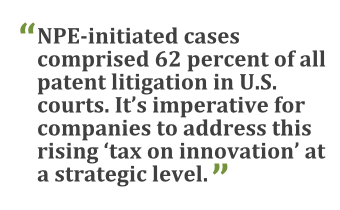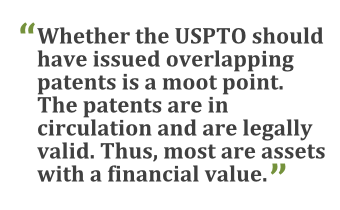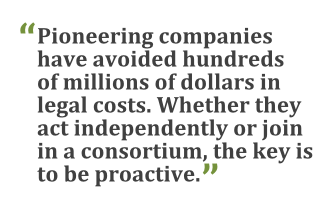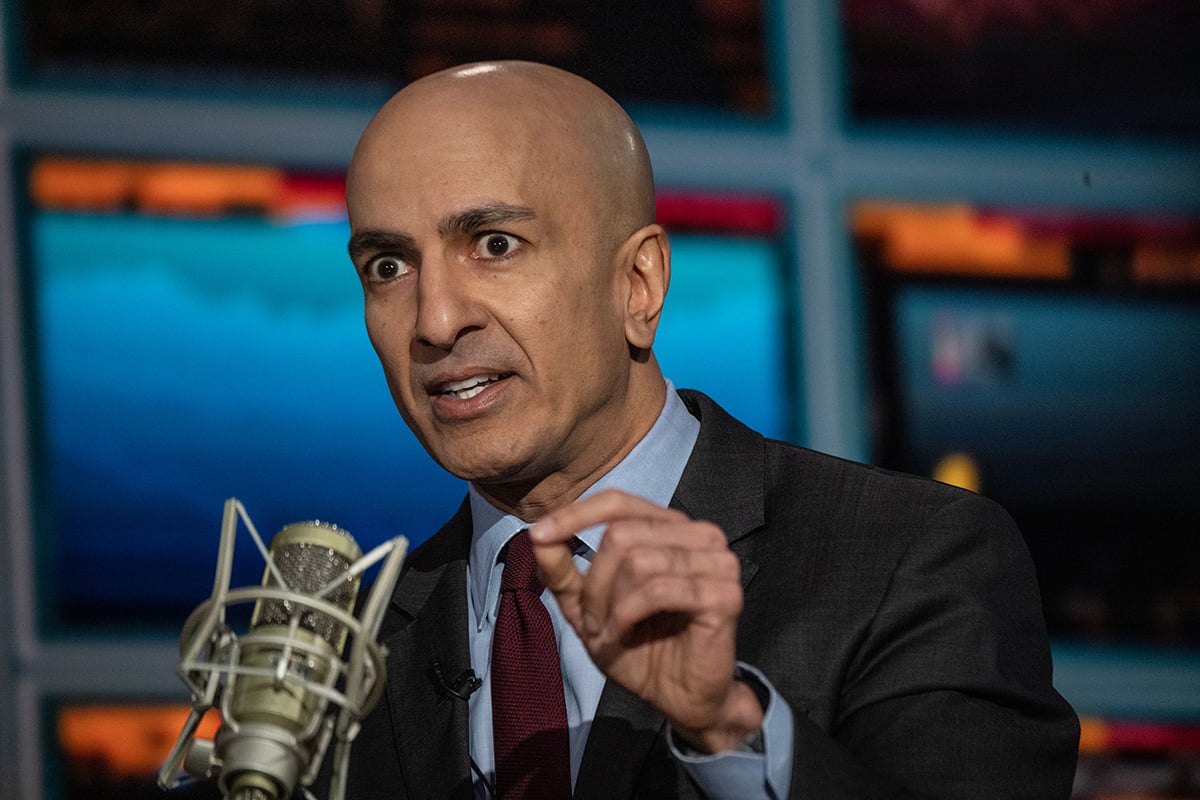 By now, most directors and executives have heard of patentlawsuits being filed by non-practicing entities (NPEs)—morecommonly known as “patent trolls.” These are companies that ownpatents but do not use those patents to produce products or provideservices. Instead, these entities are in business solely to collectlicensing fees or legal settlements from the patents they own. Theypursue these outcomes through litigation or the threat oflitigation, against businesses whose products or services allegedlyinfringe on the patents.
By now, most directors and executives have heard of patentlawsuits being filed by non-practicing entities (NPEs)—morecommonly known as “patent trolls.” These are companies that ownpatents but do not use those patents to produce products or provideservices. Instead, these entities are in business solely to collectlicensing fees or legal settlements from the patents they own. Theypursue these outcomes through litigation or the threat oflitigation, against businesses whose products or services allegedlyinfringe on the patents.
Although the concept of patent trolls may be familiar, fewmembers of the C-suite recognize just how large and costly aproblem these businesses have become. In 2012 alone, the cost ofNPE-generated litigation was nearly $11 billion, according toa recentstudy conducted by RPX, in collaboration with theCoalition for Patent Fairness. More than 2,400 unique companiesfaced at least one NPE assertion of patent infringement last year,and 270 companies fought three or more NPE lawsuits. Clearly,patent risk has become a serious strategic and operationalrisk.
|Nevertheless, most companies continue to treat patents andpatent litigation purely as the province of the legal department.They are relying on legal tactics to solve what has become a marketproblem. For risk managers at all operating companies that sell oruse technology products or services, the time is ripe for a radicalshift in thinking. It's time to insist that patents become a moreintegral part of the company's overall risk-mitigationplanning.
|Threat of Counter Suits Deters Some PatentLitigation
|The rise of NPE risk reflects the explosion in technologicalinnovation over the past two decades. As new digital technologieshave emerged and become widely adopted, the United States Patent and TrademarkOffice (USPTO) has seen a steadily rising flood of new patentapplications. For reasons too complex to explore here, that agencyhas approved and issued a large number of these patents—more than 2million since 2000. Many of these patents are ambiguously or poorlyworded, and many contain claims that overlap with previously issuedpatents. As a result, there are quite a few patents in circulationtoday that could plausibly be seen as being infringed by existingproducts and services.
|This is not as dire a situation as it might at first appear tobe. While almost all technology companies now own patents that arearguably being infringed, it turns out that patent-infringementclaims between operating businesses remain relatively rare. (Therecent Apple-Samsung litigation is a notable exception.) Mostcompanies are not in the business of copying their peers; productstrategies are usually built on progressive innovation rather thanon purposeful imitation. Therefore, for most organizations,fighting to protect yesterday's technology advantage is not apriority. They see legal battles over patents that are no longercutting-edge as a wasteful distraction in fast-moving techmarkets.
Equally important, most operating companies maintain large andbroadly applicable patent portfolios—as do their competitors. It isunderstood that a technology business will almost certainly answera claim of patent infringement with a counter claim that one of theplaintiff's products is itself infringing on a patent owned by thedefendant. Remember, the profusion of patents has made infringementan entirely plausible argument in recent years. Most companies haveaccepted the status quo, in which the threat of “mutually assureddestruction” usually prevents devastating patent fights.
|However, although this equilibrium helps keep the peace amongoperating companies, it offers no deterrent to claims of patentinfringement by NPEs, whose entire business model is built aroundacquiring patents and then asserting infringement to generatelicenses or settlements from the accused businesses. Because NPEsdo not make products or sell services, they're unlikely to fearcounter suits claiming they've infringed on the defendant company'spatent portfolio.
||
NPEs Create a “Tax on Innovation”
|The impact of NPEs has grown rapidly. As recently as 2006,approximately 1,000 U.S. businesses a year were defendants in anNPE litigation. By 2011, that number had grown to almost 3,000separate operating companies—and NPE-initiated cases comprised 62percent of all patent litigation in U.S. district courts. Today,there are nearly 800 active NPEs in the United States, and theyhave an estimated collective capitalization of more than $8billion.
|The rapid and sustained growth of NPE litigation has made it apriority for corporate executives and risk managers. Every dollarspent defending against an NPE assertion is a dollar not spent onresearch and development, market development, or job creation. It'simperative for companies to address this rising “tax on innovation”at a strategic level.
||The first step in establishing an effective strategy formitigating patent risks is for operating companies to accept thatpatents are assets. Whether the USPTO should have issued so manyoverlapping patents is a moot point. The patents are now incirculation, and unless a legal battle proves them otherwise, thepatents are legally valid intellectual property. Thus, most areassets with a financial value. The alleged users of those assets(in other words, operating companies that incorporate the patentedtechnology into their products or services) may need to pay theowners (in many cases, NPEs) for that usage.
|This is not a far-fetched notion. In point of fact, fully 95percent of NPE patent litigations settle before a verdict. In otherwords, 95 percent of the time, operating companies agree to pay fortheir use of the patent asset. It is a classic exchange of value.Unfortunately, NPEs have built a business model that relies on thelegal system to effect this exchange, and it is hard to imagine amore costly and less efficient mechanism for exchange of value thanlitigation. Of the $11 billion in total NPE costs borne byoperating companies in 2012, fully half were legal costs; the otherhalf comprised settlements and license payments.
|A Market Solution to a Market Problem
|Corporate decision-makers should be seeking market-based, ratherthan legal, solutions to NPEs' assertion of patent rights. Not allmarket solutions, however, are created equal. Some are moreeffective than others at mitigating the impact of NPElitigation. 
The simplest market solution may be for individual companies todeploy their own capital to preemptively acquire patents thatrepresent a risk of litigation. However, this strategy ofunilateral acquisition has several drawbacks. It is enormouslyexpensive; for the reasons explained above, there can be hundredsor even thousands of patents that read on a company's products orservices. This approach is also very inefficient, putting 100percent of the financial burden of clearing a patent on a singlecompany, even when the patent represents a litigation risk todozens or even hundreds of other companies. This is the so-called“free rider” problem.
|A related approach is to form a small patent-buying consortium.These have generally comprised companies with similar producttechnology profiles. They have had some success. A consortiumenables participating companies to efficiently share the cost ofpatent acquisition. It simultaneously overcomes the free-riderproblem to some degree, although the limited size of mostconsortiums means that non-participating companies usually benefitwhen a consortium buys a patent. The biggest challenge of aconsortium scenario is that buying decisions are often difficultbecause the amount of capital available for patent acquisitions maybe constrained and each patent purchase requires a unanimous vote.(Every patent does not represent the same degree of risk to everycompany.)
||A third option for dealing with NPE risk is to eschewpre-emptive buying altogether and instead deploy capital on legaldefense. Some companies have adopted this “fight hard” strategy inthe belief that if they gain a reputation as expensive andtime-consuming to sue, they will discourage NPEs from naming themin future litigation. There is little evidence, however, that thisstrategy has the desired effect. From 2008 to 2011, average growthrate of case loads for defendants in NPE cases was 36 percent, andthe growth rate was the same for companies that settled quickly asfor those that remained in litigation for more than a year.
|Intelligence in a Large-Scale Network
|One market-based approach that has proven effective is creatinga large-scale network that pools capital and enables members toshare equally in ownership of acquired patents, but leavesacquisition decisions to an independent third party. Such a networkcan overcome the logistical hurdles of a consortium and, because ofits scale, can limit the free-rider problem. And if it achievessufficient scale, it may be able to effectively acquire high-riskpatents before NPEs can buy them.
| The large-scale network model also has theadvantage of market intelligence. The more one knows about patentand litigation costs, the more effectively one can negotiateacquisitions and settlements. And if all market participants havetrustworthy information about the patents they own and the costs ofmonetizing them, there should be a steady movement away fromlitigation as a tool for exchanging patent value. As the equities,real estate, and commodities markets indicate, a more transparentmarket is a more efficient market.
The large-scale network model also has theadvantage of market intelligence. The more one knows about patentand litigation costs, the more effectively one can negotiateacquisitions and settlements. And if all market participants havetrustworthy information about the patents they own and the costs ofmonetizing them, there should be a steady movement away fromlitigation as a tool for exchanging patent value. As the equities,real estate, and commodities markets indicate, a more transparentmarket is a more efficient market.
At RPX, we believe this is the inevitable long-term trend in thepatent market, and we have seen it gain traction in our business.More and more patents are being managed without litigation, and agrowing number of companies are proactively addressing the NPEthreat, rather than waiting for the next assertion letter. The riseof defensive networks and syndicated acquisitions is allowingcompanies to collectively, and far more efficiently, reduce thecost and risk of NPE litigation.
|These are positive trends, and pioneering companies have alreadyavoided thousands of litigations and hundreds of millions ofdollars in legal costs. Nonetheless, the tax on innovation remainstoo high. Companies facing NPE risk—and this is rapidly becomingevery company that uses or incorporates technology in itsproducts—can do more. Whether they act independently or join in abroader consortium, the key is to be proactive. Doing so can helpredirect the “tax” they might pay to NPEs back intoinnovation.
|———————————————
| Ned Segal is chieffinancial officer of RPX Corporation, a leading provider of patentrisk management solutions. Founded in 2008, the firm has investedmore than $700 million in acquiring potentially problematic patentsin the open market or out of litigation that would otherwise beused offensively against its clients. The firm also executeslarge-scale syndicated transactions, provides innovative NPElitigation insurance, and delivers in-depth market intelligence andstrategic advisory services to the 160 members of its growingclient network.
Ned Segal is chieffinancial officer of RPX Corporation, a leading provider of patentrisk management solutions. Founded in 2008, the firm has investedmore than $700 million in acquiring potentially problematic patentsin the open market or out of litigation that would otherwise beused offensively against its clients. The firm also executeslarge-scale syndicated transactions, provides innovative NPElitigation insurance, and delivers in-depth market intelligence andstrategic advisory services to the 160 members of its growingclient network.
Complete your profile to continue reading and get FREE access to Treasury & Risk, part of your ALM digital membership.
Your access to unlimited Treasury & Risk content isn’t changing.
Once you are an ALM digital member, you’ll receive:
- Critical Treasury & Risk information including in-depth analysis of treasury and finance best practices, case studies with corporate innovators, informative newsletters, educational webcasts and videos, and resources from industry leaders.
- Exclusive discounts on ALM and Treasury & Risk events.
- Access to other award-winning ALM websites including PropertyCasualty360.com and Law.com.
*May exclude premium content
Already have an account? Sign In
© 2024 ALM Global, LLC, All Rights Reserved. Request academic re-use from www.copyright.com. All other uses, submit a request to [email protected]. For more information visit Asset & Logo Licensing.







